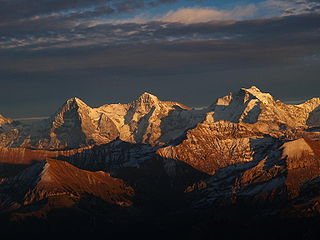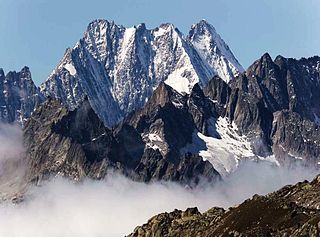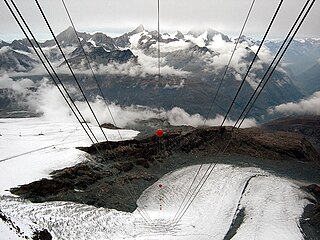
The Aare or Aar is a tributary of the High Rhine and the longest river that both rises and ends entirely within Switzerland.

The geography of Switzerland encompasses the geographical features of Switzerland, a mountainous and landlocked country located in Western and Central Europe. Switzerland's natural landscape is marked by its numerous lakes and mountains. It is surrounded by 5 countries: Austria and Liechtenstein to the east, France to the west, Italy to the south and Germany to the north. Switzerland has a maximum north–south length of 220 kilometres (140 mi) and an east–west length of about 350 kilometres (220 mi).

The Bernese Alps are a mountain range of the Alps, located in western Switzerland. Although the name suggests that they are located in the Berner Oberland region of the canton of Bern, portions of the Bernese Alps are in the adjacent cantons of Valais, Fribourg and Vaud, the latter being usually named Fribourg Alps and Vaud Alps respectively. The highest mountain in the range, the Finsteraarhorn, is also the highest point in the canton of Bern.

The Zugspitze, at 2,962 m (9,718 ft) above sea level, is the highest peak of the Wetterstein Mountains as well as the highest mountain in Germany. It lies south of the town of Garmisch-Partenkirchen, and the Austria–Germany border runs over its western summit. South of the mountain is the Zugspitzplatt, a high karst plateau with numerous caves. On the flanks of the Zugspitze are three glaciers, including the two largest in Germany: the Northern Schneeferner with an area of 30.7 hectares and the Höllentalferner with an area of 24.7 hectares. The third is the Southern Schneeferner which covers 8.4 hectares.

The Grimsel Pass is a mountain pass in Switzerland, crossing the Bernese Alps at an elevation of 2,164 metres (7,100 ft). The pass connects the Haslital, the upper valley of the river Aare, with the upper valley of the Rhône. In so doing, and as the Aare is a tributary of the Rhine, the pass crosses the continental divide between the North Sea and the Mediterranean Sea.

The High Rhine is the name used for the part of the Rhine that flows westbound from Lake Constance to Basel. The High Rhine begins at the out flow of the Rhine from the Untersee in Stein am Rhein and turns into the Upper Rhine in Basel. In contrast to the Alpine Rhine and Upper Rhine, the High Rhine flows mostly to the west.
German submarine U-772 was a Type VIIC U-boat of Nazi Germany's Kriegsmarine during World War II.

The Lauteraarhorn is a peak of the Bernese Alps, located in the canton of Bern. Together with the higher Schreckhorn, to which it is connected by a high ridge, it lies between the valleys of the Lower Grindelwald Glacier and the Unteraar Glacier, about 10 kilometres southeast of Grindelwald, the closest locality. The Lauteraarhorn belongs to the Aaremassif and is surrounded by large glaciers: the Lauteraargletscher and the Strahlegg-Gletscher and the Obers Ischmeer. Being off the main ridge of the Bernese Alps, all the glaciers surrounding the Lauteraarhorn and the Schreckhorn are part of the Aare basin. The Lauteraarhorn is the second highest summit lying wholly within the canton of Bern. Administratively, it is split between the municipalities of Grindelwald and Guttannen.

The Unteraargletscher, literally "Lower Aare-Glacier", is the larger of the two sources of the Aare river in the Bernese Alps. It emerges from the association of the Finsteraargletscher and the Lauteraargletscher and flows for about 6 km (3.7 mi) to the east down to the Grimselsee near the Grimsel Pass. In total the glacier was 12.95 km (8.05 mi) long and 29.48 km2 (11.38 sq mi) in area in 1973. Its lower end is almost 400 metres lower than that of the neighbouring Oberaargletscher.
German submarine U-702 was a Type VIIC U-boat built for the Nazi Germany's Kriegsmarine for service during World War II. She was under the command of Kapitänleutnant Wolf-Rüdiger von Rabenau.
German submarine U-756 was a Type VIIC U-boat built for Nazi Germany's Kriegsmarine for service during World War II. Laid down as yard number 139 at the Kriegsmarinewerft (KMW) in Wilhelmshaven, she served with 6th U-boat flotilla from 30 December 1941 until 1 September 1942 under the command of Kapitänleutnant Klaus Harney. U-756 did not survive to complete her first patrol and did not sink or damage any ships.

The Schneeferner in the Bavarian Alps is Germany's highest and largest glacier.

The Hallstätter Glacier is the largest glacier in the Dachstein Mountains. It lies immediately beneath the northern foot of the Dachstein itself and runs down to the Eissee lake below the Simony Hut at a height of 2,205 m. To the east the Hallstätter Glacier is bounded by the High Gjaidstein. Firmly sealed off at its western snout by the Schöberl, 2,426 m, it is bordered in the west by the eastern flank of the Hohes Kreuz ridge, running from south to north, which reaches a height of 2,837 metres. In its upper third the glacier flows around a prominent landmark, the Eisstein. At its head in the south it is also bordered by the Hunerkogel and the Dirndln.

Berchtesgaden National Park is in the south of Germany, on its border with Austria, in the municipalities of Ramsau bei Berchtesgaden and Schönau am Königsee, Berchtesgadener Land, Free State of Bavaria. The national park was established in 1978 to protect the landscapes of the Berchtesgaden Alps. Headquartered in the town of Berchtesgaden, the park was designated a UNESCO Biosphere Reserve in 1990.

Gletsch is a hamlet in the German-speaking half of the canton of Valais, located in the upper Rhone valley, called Obergoms, 2.5 kilometres (1.6 mi), southeast below the Rhone Glacier's mouth and itself the headwaters of the Rhône. It is called Gletsch, since the first building was the predecessor of the Hôtel Glacier du Rhône built more or less just next to the glacier's mouth in 1830.

The Theodul Glacier is a glacier of the Alps, located south of Zermatt in the canton of Valais. It lies on the Swiss side of the Pennine Alps, although its upper basin touches the Italian region of the Aosta Valley. The glacier descends from the west side of the Breithorn and splits into two diverging branches above Gandegg: the Upper Theodul Glacier, spilling on a high plateau near Trockener Steg, together with the Furgg Glacier, and the Lower Theodul Glacier, reaching a height of about 2,500 metres (8,202 ft) above the Gorner Glacier. Both branches are part of the Rhone basin, through the rivers Gornera, Mattervispa, and Vispa. Slightly above the glacier splitting is the Theodul Pass, crossing the border between Switzerland and Italy, and connecting Zermatt to Breuil-Cervinia. On the west, the Theodul Glacier is overlooked by the Matterhorn.
German submarine U-984 was a Type VIIC U-boat built for Nazi Germany's Kriegsmarine for service during World War II. She was laid down on 7 September 1942 by Blohm & Voss, Hamburg as yard number 184, launched on 12 May 1943 and commissioned on 17 June 1943 under Oberleutnant zur See Heinz Sieder.

The Übergossene Alm is the name of the summit region of the Hochkönig (2,941 m) in the Berchtesgaden Alps. It contains the remains of a glacier that used to cover almost the entire summit plateau; in 1888 around 5.5 km² of the plateau was covered by an ice sheet. Since then the glacial surface has melted until it now covers just 1.5 km² and the glacier has split into three, small crevasse-free areas. The name of the glacier goes back to a local legend.


















